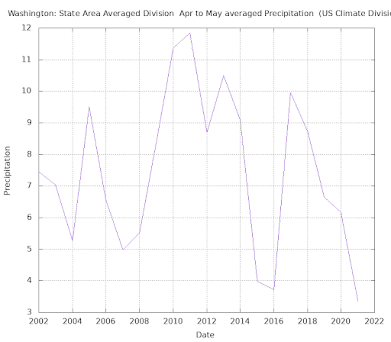This blog discusses current weather, weather prediction, climate issues, and current events
May 30, 2022
Bad News. Clouds will Obscure the Meteors for Most of Washington State
May 29, 2022
Warmth and Meteors Ahead!
I am really looking forward to two events this week: the potential for a meteor storm on Monday evening and the arrival of warmer than normal conditions on Tuesday and Wednesday.
First, the meteors. On Monday between 9:45 PM and 10:15 PM, the tau Herculid meteor shower will reach the earth. There is considerable uncertainty on the number of meteors that will enter the earth's atmosphere, but it potentially could be a major event.
The latest high-resolution weather model output suggests that it may be clear or nearly clear over much of the Northwest (see cloud forecast map for 11 PM below)
By the end of the shower (around 10:15 PM), it will look like this (see below). Maybe we will have a chance then of seeing some meteors.
May 27, 2022
A Complex Memorial Day Weekend Forecast. Are These Weekends Getting Better or Worse?
My podcast today (see below to access it), will describe the active and varied weather that will strike the region this weekend. But there is more: I will talk about the history of Memorial Day Weekend weather and how it represents a transition time into June Gloom.
A major feature this weekend is an unusually strong low-pressure center that will make landfall on the Oregon coast on Saturday afternoon (see below), with moderate rain extending over Oregon and powerful winds along the coast. If you are vacationing in Oregon this weekend... sorry.
To listen to my podcast, use the link below or access it through your favorite podcast service.
May 24, 2022
Wildfire Forecast for the Summer
Several people have asked me about the threat of wildfires for our region this summer.
I have good news for them: the wet/cool spring and other factors make a major wildfire season in Washington State highly unlikely. That means less low-level smoke and other impacts.
Why are folks so nervous? A major stimulus has been irresponsible media, such as the Seattle Times.
For example, Seattle Times cartoonist David Horsey published a recent cartoon showing Washington State on fire, with flames and smoke extending over the entire state (see my rendition of his cartoon below).
And ST's David Horsey doesn't stop there in inducing fear:
Consider Wenatchee on the eastern side of the Cascades and near the eastern Washington fire area. For the period April 1-May 23, Wenatchee "enjoyed" the wettest year since 2011 (see below)
Take home message: spring temperature/precipitation is correlated with summer wildfire area over the state, and this spring has brought very similar conditions (cool/wet) as experienced in 2011, whose summer had minimal wildfires.
Obviously, a cool, moist June delays the fire season.
May 22, 2022
Lightning Fest over the Northwest
Thunder was heard all over the Northwest on Saturday, including many areas without a drop of rain.
Take a look at the lightning strike map for Saturday. Quite a few lightning strokes over the western slopes of the Cascades and Rockies....and a number of boomers moved over southeast Washington.
Yesterday morning one could see the cumulus convection start to pop up over the Cascades, and by early afternoon (2 PM for the Seattle Panocam shown below) there was fairly deep convection (the meteorological term for cumulus clouds) with prominent cirrus anvils.
Today the thunderstorms will be absent from the region--so enjoy.
And better enjoy this weekend. Memorial Day weekend is going to be memorable...but NOT for nice weather.
May 20, 2022
The Best Weekend in a While, Plus Why Eastern Washington is NOT in a Drought
My new podcast is out.
I start with a very favorable weekend forecast for most of the region, with warm, dry conditions over the lowlands of western and eastern Washington.
Only the mountains may get some showers on Saturday.
And then I take on the exaggerated claims of drought in eastern Washington.
I start by referring to the climatological precipitation map of Washington, noting that much of the Columbia Basin is desert, with less than 10 inches a year.
Only with irrigation is agriculture possible and a small shortfall of precipitation is meaningless.
In the podcast, I review the favorable water situation that is now occurring and will be present throughout the summer for eastern Washington, with little negative impact expected on agriculture.
Bottom line: there is no drought in eastern Washington, by any relevant measure.
To listen to my podcast, use the link below or access it through your favorite podcast service.
Massive Mountain Snow and Flakes Down to Sea Level
For those worried about below-normal mountain snow, your worries are over..... a major snow dump is ahead. You can also expect great skiing,...

-
In act one of this meteorological drama, yesterday and this morning brought heavy rain and flooding to many sections of western Washington. ...
-
The heavy rainfall is over, but some rivers are still rising. The most impactful atmospheric river event of the past few decades. Consider...



.png)







.gif)

.png)
.png)








.png)

.png)




















